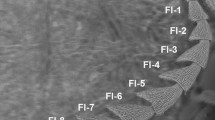Abstract
Antennal cropping, a behavior inferred to exist because queens and kings have shorter antennae than fresh alates, is widespread in termites. However, the proximate and ultimate mechanisms underlying this phenomenon remain unclear. We studied the occurrence of antennal cropping in queens and kings of the dry-wood termite Neotermes koshunensis (Kalotermitidae). Observation of the antennal tip structure with scanning electron microscopy and the occurrence of antennal cropping in new kings and queens reared in isolation indicated that self-cropping is an important proximate mechanism. Previous studies inferred that antennal cropping may play a key role in the life-history of alates at the colony-founding stage. However, we also found antennal cropping in adultoid reproductives (secondary reproductives) that had not experienced a colony founding. We propose a new hypothesis that antennal cropping is important for individuals in regulating their physiology when they change from the non-reproducing to the reproducing phase.




Similar content being viewed by others
References
Abe T. 1987. Evolution of life types in termites. In: Evolution and Coadaptation in Biotic Communities (Kawano S., Connell J.H. and Hidaka T., Eds), University of Tokyo Press, Tokyo, pp 125-148
Costa-Leonardo A.M. and Barsotti R.C. 1998. Swarming and incipient colonies of Coptotermes havilandi (Isoptera, Rhinotermitidae). Sociobiology 31: 131-142
Heath H. 1903. The habits of California termites. Biol. Bull. 4: 47-63
Hewitt P.H., Watson J.A.L., Nel J.J.C. and Schoeman I. 1972. Control of the change from group to pair behavior by Hodotermes mossambicus reproductives. J. Insect Physiol. 18: 143-150
Ikehara S. 1966. Distribution of termites in Ryukyu Archipelago. Bulletin of Arts and Science Division, University of the Ryukyus (Mathematics and Natural Sciences) 9: 49-178
Katoh H., Matsumoto T. and Miura T. 2007. Alate differentiation and compound-eye development in the dry-wood termite Neotermes koshunensis (Isoptera, Kalotermitidae). Insect. Soc. 54: 11-19
Lüscher M. 1961. Social control of polymorphism in termites. R. Entomol. Soc. London. 1: 57-67
Mensa-Bonsu A. 1976. The biology and development of Porotermes adamsoni (Froggatt) (Isoptera, Hodotermitidae). Insect. Soc. 23: 155-156
Myles T.G. 1999. Review of secondary reproduction in termites (Insecta: Isoptera) with comments on its role in termite ecology and social evolution. Sociobiology 33: 1-91
Nalepa C.A., Evans T.A. and Lenz M. 2011. Antennal cropping during colony foundation in termites. ZooKeys 148: 185-196
Nel J.J.C. 1968. Aggressive behaviour of the harvester termites Hodotermes mossambicus (Hagen) and Trinervitermes trinervoides (Sjöstedt). Insect. Soc. 15: 145-156
Roisin Y. 2000. Diversity and evolution of caste patterns. In: Termites: Evolution, Sociality, Symbioses, Ecology (Abe T., Bignell D.E. and Higashi M., Eds), Kluwer Academic Publishers, Dordrecht, pp 95-119
Watson J.A.L., Nel J.J.C. and Hewitt P.H. 1972. Behavioral changes in founding pairs of the termite Hodotermes mossambicus. J. Insect Physiol. 18: 373-387
Weesner F.M. 1969. External anatomy. In: Biology of Termites, Vol. 1 (Krishna K. and Weesner F.M., Eds), Academic Press, New York, pp 19-47
Yamamoto Y. and Matsuura K. 2011. Queen pheromone regulates egg production in a termite. Biol. Lett. doi: 10.1098/rsbl.2011.0353
Acknowledgments
We thank S. Dobata (PhD of University of Ryukyus) and K. Matsuura (Professor of Kyoto University) who gave us invaluable advice, and H. Iwakiri (Associate Professor of University of Ryukyus) for assistance in using the scanning electron microscope system.
Author information
Authors and Affiliations
Corresponding author
Rights and permissions
About this article
Cite this article
Miyaguni, Y., Sugio, K. & Tsuji, K. Antennal cropping in the Asian dry-wood termite, Neotermes koshunensis . Insect. Soc. 60, 223–229 (2013). https://doi.org/10.1007/s00040-013-0286-6
Received:
Revised:
Accepted:
Published:
Issue Date:
DOI: https://doi.org/10.1007/s00040-013-0286-6




